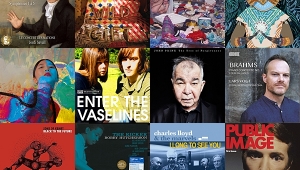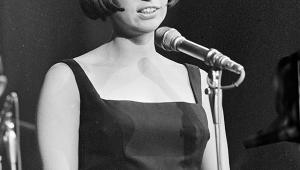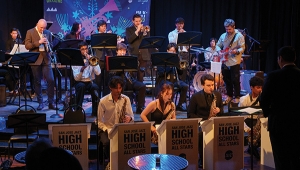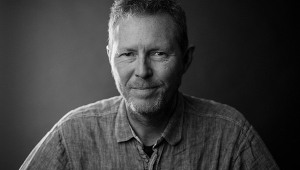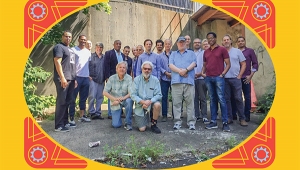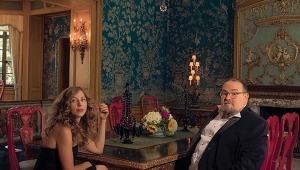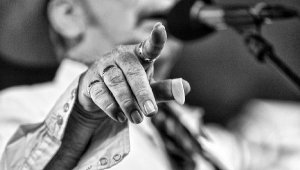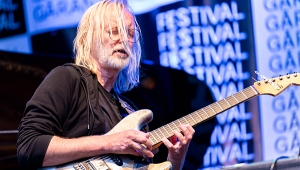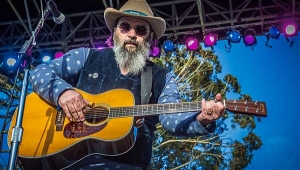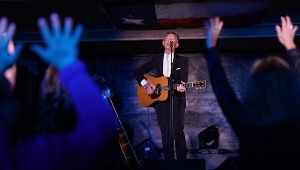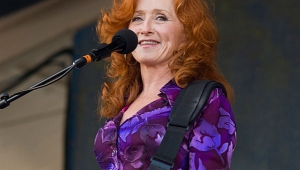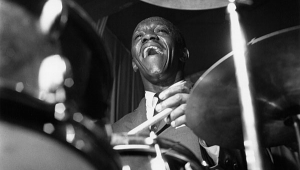| Columns Retired Columns & Blogs |
Ry Cooder: The Boy and The Bubble Page 2
Since the late '70s, Cooder has also provided music for a number of films, including The Long Riders, Cocktail, Steel Magnolias, and Paris, Texas. In 1992, he was briefly in a latter-day roots-rock "supergroup," Little Village, which tried unsuccessfully to re-create the magic that the same four players (Cooder, John Hiatt, Nick Lowe, and Jim Keltner) had tapped into while making Hiatt's Bring the Family in 1987. His venture into world music began in 1993, when he recorded A Meeting by the River with V.M. Bhatt for Water Lily Records, an independent audiophile world-music label. And in 1994, Cooder and West African guitarist Ali Farka Toure won Grammys for their collaboration, Talking Timbuktu (Hannibal).
Prodding practicing musicians into speaking about the sound of their records can be hard work. Most are content to leave such matters to producers or, more likely, engineers. Hence all the genuinely bad-sounding rock records out there crowding for shelf space. Mambo Sinuendo does not suffer from that problem. If anything—it's almost a pleasure to be able to write this—this album may have suffered from too much attention paid to its sound.
Cooder and engineer Jerry Boys went to great lengths, both in the EGREM studios in Cuba and while mixing the project back in the States at vintage Capitol Studios in L.A., to get the sound right. An innocent question about sound unleashed from Cooder a torrent of response, the likes of which 99.9% of modern musicians would neither care about nor understand.
"In EGREM you could see that the sound of Galbán's electric guitar was fantastic. It filled the room in such a way, in a saturated way, that we don't think of electric guitar these days. To my ears, I don't hear this. What I hear (today) is direct. I hear a lot of signal-processing. I hear a lot of stuff that shrinks (the sound) down so it cuts through this or that foot pedal, so it cuts though this or that thick web of effects. And clean. Cleaner and cleaner.
"EGREM is a studio with tall ceilings, very deep. And it has all these wood surfaces, the floor is wood, old, distorted from time and water damage. Very porous, you know. There's so much water damage, it's like a honeycomb, like a sponge. So it breathes and moves and you really can feel this. Moreover, it's on the second story of a building, so underneath there's a lot of air. So it has a certain breathing in the floor, as opposed to cement—the idea of the studio within cement that I just think is totally wrong. Stability is not the key. It's movement that is key.
"The first Buena Vista record [also recorded at EGREM] was an exercise in acoustic music. So it was a lot of people. By the end of that record, we pretty much understood where in the room you go. There's a halfway imaginary line down the middle of the room, and if you're way in the back, it doesn't happen—you've got to get towards the front. And you set up around the bass, as they used to do, see. I looked at a lot of pictures of where were they standing, how far apart. I studied all these things.
"But then you add electric instruments and a snare drummer and some cymbals, 'cause two drummers with maybe 50 surfaces between them...well, more than that. You've got like 10 different bass drums that are being hit, garbage cans, little things with goat skins on 'em, I mean all kinds of shit—a cymbal the size of a gong. So you know that the drums take over and so the drums are key. So you have to position the microphones, the people around the drums to make sure that the drums on one hand feel good, and that they combine to the microphone as one. Because if the microphone hears two drummers, it's going to feel very strange. It's going to feel very clumsy. But if they can play as one, which they know how to do, so not everybody's hitting the bass drums, not everybody's playing snares—more of a spectrum, you know, like film music. Because if it's pop or rock, then it's very programmatic, and everybody's business as usual and so what's the point? But if you do it as though it were a film score, then you have space and you have size and it's sort of a little more complex, a little more interesting.
"There's a war between too much sound in the mikes and not enough excitement. Usually, when you have enough excitement and everybody's really rocking, you know, it's so goddamned charged and saturated you can't work with it. That's like direct to 78 or something. And I don't think we wanted that, because then you lose the fantasy of the environment. It sounds too much like a jam. Like a garage record."
Fantasy of the environment? Before I can ask about this, Cooder is answering in one long rush of thought.
"I always thought that the early music from the '30s and '40s had a very flat quality. So you don't feel environments, you don't even hear it—unless you're talking about Caruso in Carnegie Hall, (where) you might catch some of it. But generally you don't, because they hadn't invented tape, and tape is very good for this. And the microphones were good, but they got better, a lot better. So the microphones picked up more ambience and more harmonics, and harmonics is really what it is. Because harmonics live in an air space. We hear harmonics very well—which to me is the halo, or the bubble, as I like to call it. It's like a very transparent sheen on everything. And the bubble is a good feeling. It's like a balloon you can feel the edges of. If it's diffused and goes away, then that's loss of energy, loss of emotional containment, and I'm just as bored as anything. I can't stand that.
- Log in or register to post comments
